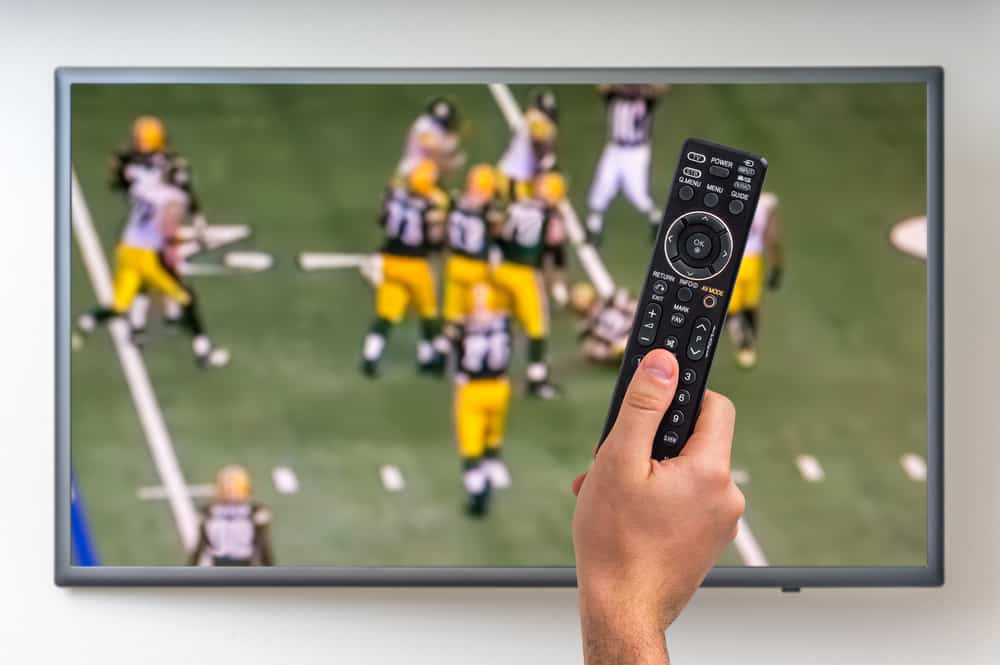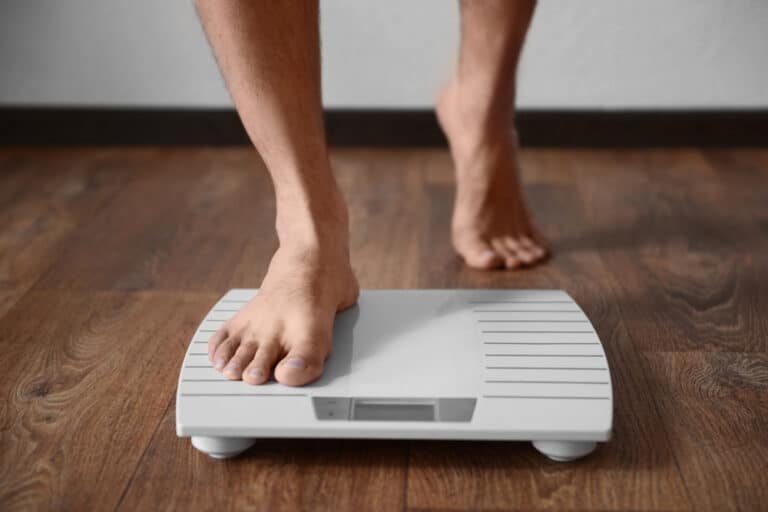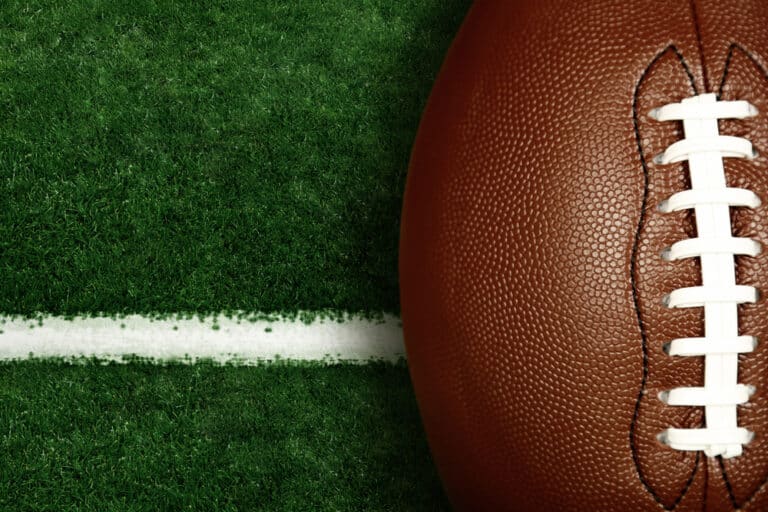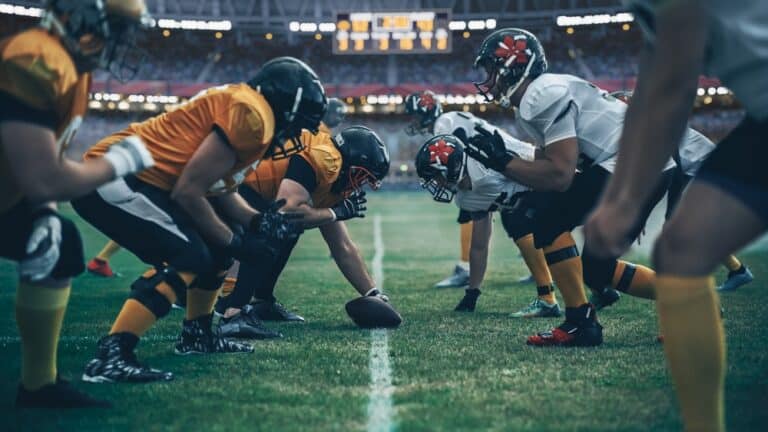Why Do Football Fields Look Bigger On TV? (All The Interesting Facts)
Editorial credit: Elliott Cowand Jr / Shutterstock.com
You switch on the big game, and it opens to a stadium you’ve visited before, one you’re familiar with. For a moment, you grow confused. Have they expanded the field? You’d also been to a college match earlier in the year, but on the television, in your living room, the NFL football field feels vastly more extensive than the fields you saw in person. Why do football fields look bigger on TV?
All football fields are the same size, but one may seem bigger on television than in person due to optical illusion. The stadium’s infrastructure and the inability to see the entire field in one camera shot make the field seem bigger. TVs offer a limited viewpoint focused on the action.
We rely on our televisions to transport us to the scene of the action. We burn with the desire to cheer for our favorite sports teams, even in the comfort of our homes. But, sometimes, this leaves us with questions about fields and cameras and why everything seems so different. Don’t stress! You can get back to your game in a moment, as your concerns regarding the field size are answered right here.
What Makes Football Fields Look Larger On TV?
Watching football games in person versus on TV will bring about different feelings and expectations. When you’re standing in a crowd of fans, chanting, and being swept away by the excitement, the stadium or sidelines may feel at the same time like the whole world and a tight-knit community. The field and stands are within reach.
When you jump up and yell at the referee over a foul play in the comfort of your home, you’re essentially yelling at your TV and maybe the friend who disagrees sitting on your couch. You are separate from the stadium and unable to reach out to the players stuck within your TV screen. Besides, you could rewind the game in the break to gain further insight.
As you rewind, you compare how large the field looks opposed to a high school or college field. This size difference is because watching on a TV creates distance and perspective. Putting yourself behind a camera’s lens and being reduced to only that viewpoint will make the field seem much bigger than it would in person. Plus, professional stadiums seem grander by the sheer magnitude of their architecture.
How The TV Tricks Your Brain When Watching Football
The fact is that your old college football field and your child’s high school football field are no smaller than the fields played on by professional league NFL players. The difference lies with you rather than the field itself. Your perception has changed.
How Camera Angles Change Your Perception
As the camera follows the players and the ball across the field, it zooms in and out, changing angles and speeds to give the viewer the best seat in the house. Thus, your field of view is limited to the camera, and the camera essentially becomes your eyes.
If you were watching the game in person, you would be able to see the entirety of the field and then some. But the TV is locked on the action and will only ever show part of the field from post to post. The bird-eye view the camera grants of the game is a matter of detail rather than scope. In theory, you may see more of the field, but those sections are snippets rather than a whole.
As your eyes track them on the TV, the player runs, and the field seems to go on forever. Yet, the field does not go on forever. You’ve been duped. A ground-level camera makes the player’s scope of the field into your own. Running across 100 yards seems much longer than watching someone else do it, and you’re now level with the player.
Even watching the game from an elevated angle (top view), you lose a sense of the field’s size as the camera shows you the center of the action and not the entirety of the field. You don’t have the advantage of comparing the players to their surroundings as quickly as you would if you were at the stadium.
How A Stadium’s Size Changes Your Perception
Another factor that features in the illusion is the sheer magnitude of professional stadiums. High school and college games may have a few bleachers or a fancy velodrome, but NFL stadiums are built to house tens of thousands of spectators. These stadiums are feats of architecture that provide atmosphere along with seating. They must cater to the hungry masses and have suitable ablution and security areas.
Between the cameras and the monstrous architecture encircling the field, it’s no wonder your mind thinks the field is a different size than it is.
Cameras Used For Filming NFL Games
Football games are recorded by between 10 and 20 cameras depending on the game league, stadium, and budget appointed toward the game, among other factors. What you see on your television is the camera operators switching between the many cameras to afford you the best shot of the game. Many cameras are on ground level, and a few are suspended above and around the field.
Two additional cameras are mounted to give coaches and trainers the ability to scout players and assess the game for injuries or evaluate officials. The unique camera footage has recently been made available to fans with Game Passes. The cameras are expressly set up to show a dedicated view of the end zones and the entire field, including all players. The second is referred to as an All-22 camera.

What Size Is A Football Field?
From end to end, including the end zone, a football field is 120 yards (109.7 meters) in length and 53 1/3 yards (48.8 meters or 160 feet) wide. The end zones occupy 10 yards on either side of the field’s length, which is the space beyond the goalposts.
Nine lines divide the field into ten equal zones. A zone line marks every ten yards on the field with a number ranging in the tens (i.e., 10, 20, 30), with the center of the field marked 50 yards. Within the zones are yard lines that mark every 5 yards. The 5-yard marks, like the zone lines, cut across the width of the field.
There are shorter lines called hash lines placed intermittently along the width of the field between 5-yard lines. The hash lines are another reason fields may come across as different sizes.
School and professional NFL fields are the same in size. However, spacing between hash lines differs with the type of play. NFL hash lines are 18.6 feet apart, while college hash lines are 40 feet apart, and school hash lines tend to be 53 feet apart.
Conclusion
Football fields on your television are not differently sized from what you’ve witnessed in person. Their size difference is an illusion created through camera angles and the focused zooms of the cameras. Your awareness is shifted to individuals rather than the field, so you perceive the field as more extensive than it is.
References
- https://www.quora.com/Why-is-it-that-televised-sporting-events-like-soccer-always-seem-to-make-the-field-look-larger-than-it-does-in-real-life
- https://www.reddit.com/r/explainlikeimfive/comments/m9fxlv/eli5_why_does_a_footballrugby_pitch_looks/
- https://www.stack.com/a/the-dimensions-of-a-football-field/
- https://operations.nfl.com/gameday/technology/impact-of-television/







